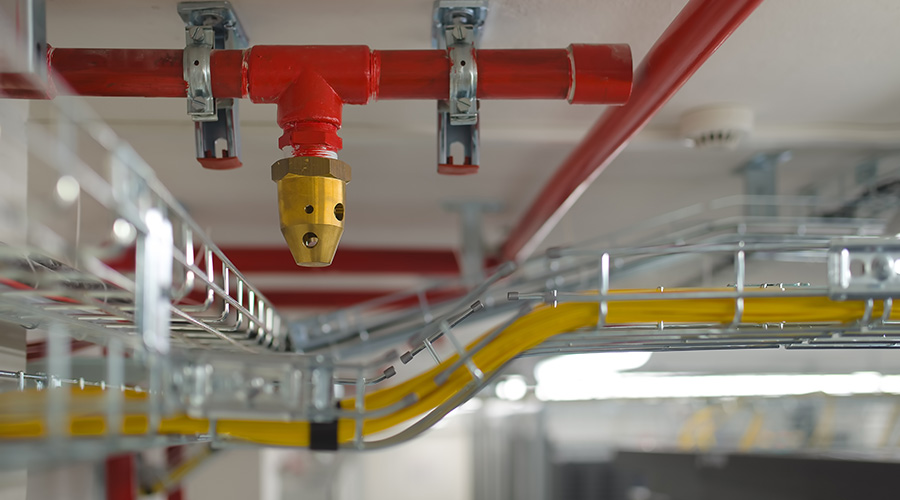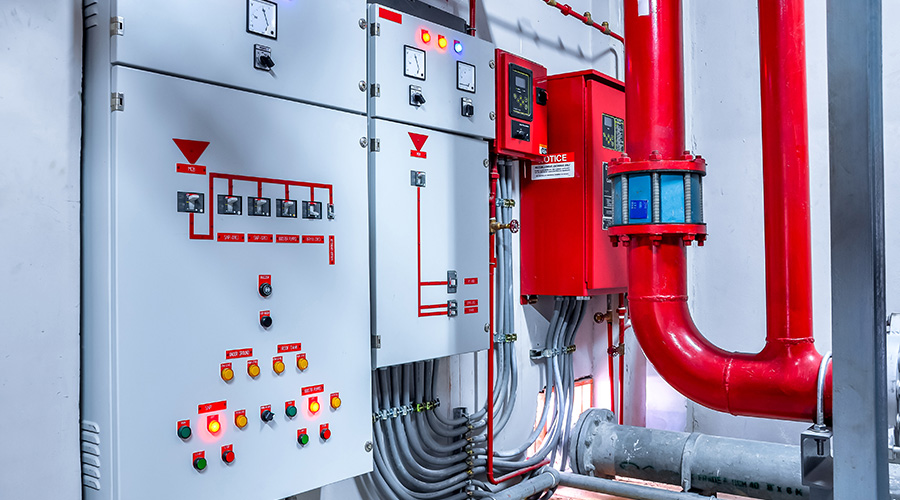 A busy open office may require strobes and alarms designed for larger areas in order for the notification to be noticed.
A busy open office may require strobes and alarms designed for larger areas in order for the notification to be noticed.Shifting Facility Technologies Create Fire Safety Challenges
From energy storage systems to solar panels, facility managers need to know how what's in or on their building affects their fire safety systems and strategies.
One of the biggest fire safety concerns stems from shifts in the way in which facilities are used. “Buildings tend to morph over time,” says Todd E. Smith, project manager with RMF Engineering. As they do, buildings may gradually exceed the capabilities of their existing fire and life safety systems, he adds.
A building expansion may increase the water needed to contain a fire beyond the capabilities of the existing supply. Egress paths, exit signage, and fire alarm device locations also may need to change. “Look closely at existing fire and life safety systems when there is a change of use or occupancy,” Smith adds.
Similarly, altering the items stored in a room or building can impact its fire safety, Poole notes. For instance, many furniture pieces and even computers contain greater quantities of plastic than they did ten or twenty years ago. “It creates a higher fire challenge,” he says. Often, more water is needed to control fires involving plastic than those that don’t, he adds.
Another trend in building use is specific to some warehouses. “We want bigger, taller warehouses,” Jelenewicz says. However, taller storage racks can lead to hotter and faster moving fires.
The shorter distances between racks of stored items, often seen in automated storage operations, also is causing some concern. As picking tools have become more automated and reduced the need for forklifts, warehouse managers often move racks closer together. The impact of this on fire safety still is being researched, Jelenewicz says.
The sprinkler industry has worked to keep pace with the changes in warehouses, Jelenewicz says. “We are seeing a resurgence of rack sprinklers that are installed in the storage racks, enabling water to move to any fire more quickly.” While previous installations often limited the building owner’s ability to change storage configurations, newer ones offer greater flexibility.
Another technical advance, early suppression fast response (ESFR) sprinklers installed at ceilings, has provided flexibility for storage arrangements. However, as rack heights continued to grow, these also proved less effective, Jelenewicz says. Now, some organizations are using both rack and ceiling sprinklers, he adds.
Exploding lithium batteries are a concern not just on airplanes. Managers and owners with facilities that store products with lithium batteries should pay particular attention to fire safety, as existing sprinkler systems may not provide adequate protection, Moore notes.
Energy storage systems (ESS) are still in an early phase of deployment, Solomon says, and come in a range of technologies and battery chemistries. “It is anticipated that as ESS use becomes more commonplace, it will be critical for facility managers to have a good understanding of not only the types of ESS being considered, but also the impact the system can have for first responders,” Solomon says.
For instance, fire department preplanning for the building will have to consider the location of the ESS within a structure, shut down or isolation procedures, and any special precautions about the firefighting operations, Solomon says. NFPA is currently addressing some aspects of this issue through the code development process, starting with the electrical code, NFPA 70, National Electrical Code and the fire code, NFPA 1, Fire Code, he says.
In addition, due to the unique nature of ESS, NFPA identified a need to provide a dedicated standard to cover the different components, technologies and hazards in a comprehensive manner, Solomon says. A new committee was formed in 2016 to look at the various technologies, battery chemistries, configurations, and arrangements ESSs could take on. That committee just started meeting to develop an outline for a new standard.
Another risk, Poole says, is that in the event of a fire, the fire department often cuts power to the building for safety reasons. However, if batteries or the solar system continue to supply energy, that can create an electrocution hazard for fire fighters. One solution is to install a disconnect to the batteries or solar system so the alternate power system also can be disconnected. The fire department should be made aware of the alternate power sources so they can limit their risk of injury and electrocution, he adds.
Related Topics:















